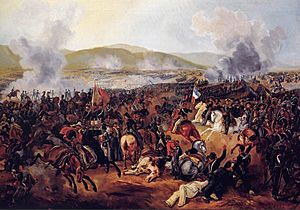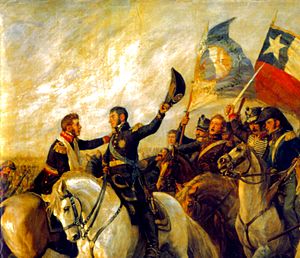Battle of Maipú facts for kids
Quick facts for kids Battle of Maipú |
|||||||
|---|---|---|---|---|---|---|---|
| Part of the Chilean War of Independence | |||||||
 Battle of Maipú, painted in 1837 |
|||||||
|
|||||||
| Belligerents | |||||||
| Commanders and leaders | |||||||
| Strength | |||||||
| 5,000 21 guns |
5,000 12 guns |
||||||
| Casualties and losses | |||||||
| 1,000 | 2,000 killed 3,000 captured |
||||||
The Battle of Maipú (Spanish: Batalla de Maipú) was a very important fight near Santiago, Chile. It happened on April 5, 1818, during the Chilean War of Independence. In this battle, South American rebels, also called Patriots, fought against Spanish royalists. The Patriots were led by an Argentine general named José de San Martín. They completely defeated the Spanish forces, which were led by General Mariano Osorio. This victory helped Chile become truly independent from Spain.
Contents
Why the Battle Happened
In 1817, General José de San Martín from Argentina led his army across the Andes mountains. They won battles at Chacabuco and Chalchuapa, and took control of Santiago. But the Spanish government in Peru sent a new army to Santiago. This army, led by General Mariano Osorio, defeated San Martín at the Second Battle of Cancha Rayada.
Even after this loss, the desire for independence didn't stop. The next year, San Martín started a final attack. This attack would decide who would win the war. After their defeat, the Patriot army quickly got back together. In less than two days, they had about 4,000 men ready to fight again.
By April 2, the Patriot army was strong and organized. They had about 5,000 soldiers and officers. Meanwhile, the Royalist army kept trying to win. They chased the Patriots, but the Patriots fought back in every town. This slowed down the Royalists' march towards Santiago. It also gave the Patriots time to get ready.
General Bernardo O’Higgins helped a lot. He collected weapons and got more supplies. He also gathered fighters from different areas. He set up a training camp to get the troops ready. General Osorio realized that the Patriot army was still strong. He knew another big fight near Santiago was going to happen.
Getting Ready for Battle
Both armies set up their camps close to each other, south of Santiago. San Martín and Osorio prepared their soldiers for the big fight. On the night of April 4, the Royalist army camped at a place called Lo Espejo. This was about seven kilometers from the Patriot forces.
The next morning, San Martín placed his army on some low hills. His divisions were arranged carefully. Las Heras's division was on the right. Alvarado's division was on the left. Other troops were behind them. The artillery (cannons) was split into two groups. They were protected by soldiers on the sides. Osorio also arranged his army on a triangular hill. His divisions were placed on the left, right, and center.
The Battle Begins
The battle started around 11:30 AM when the Patriot cannons fired. The Royalist cannons fired back, but no one was hurt at first. After about 30 minutes of shooting, San Martín ordered his troops to move forward. Las Heras's soldiers attacked the Royalists on the left. Alvarado's soldiers attacked on the right.
The Patriot grenadiers (special soldiers) were attacked by some Royalist cavalry (soldiers on horseback). But the grenadiers fought back and chased the attackers. The Royalist cavalry was then hit hard by Patriot soldiers and cannons. The grenadiers were reinforced and attacked again. They successfully scattered the enemy cavalry and protected the Patriot right side. During this fight, Chilean Colonel Santiago Bueras sadly died.
In the middle of the battlefield, both armies' foot soldiers fought fiercely. The Royalist division, reinforced with more troops, pushed the Patriot line back a little. But San Martín sent in three more battalions (groups of soldiers). These new troops attacked and broke through the Royalist lines. The remaining Royalist groups fought bravely. They faced many cavalry attacks but had to retreat. At this point, General Osorio left the battlefield. He left his army under the command of Ordoñez.
Ordoñez gathered some soldiers and made a final stand at a farm. They fought hard, but San Martín ordered his cannons to fire on their position. The Patriot soldiers pushed forward. Ordoñez's men, trapped in the farmhouses, were forced to give up. Meanwhile, other Patriot groups captured the scattered Royalist soldiers.
What Happened After
The battle was a huge victory for the Patriots. About 2,000 Spanish soldiers died, and 3,000 were captured. The Patriots lost around 1,000 men. This victory was very important. It ended the main Spanish military actions in Chile.
The win also allowed the Chilean and Argentine Patriots to attack Spanish areas along South America's Pacific coast. This eventually led to the freedom of large parts of Peru from Spanish rule.
This historic victory is celebrated every year on April 5. There is a parade in Maipú, where the battle took place. The last Sunday of April also has a special event where people act out parts of the battle. This ends a month of national celebrations for the victory.
Images for kids
See also
 In Spanish: Batalla de Maipú para niños
In Spanish: Batalla de Maipú para niños






